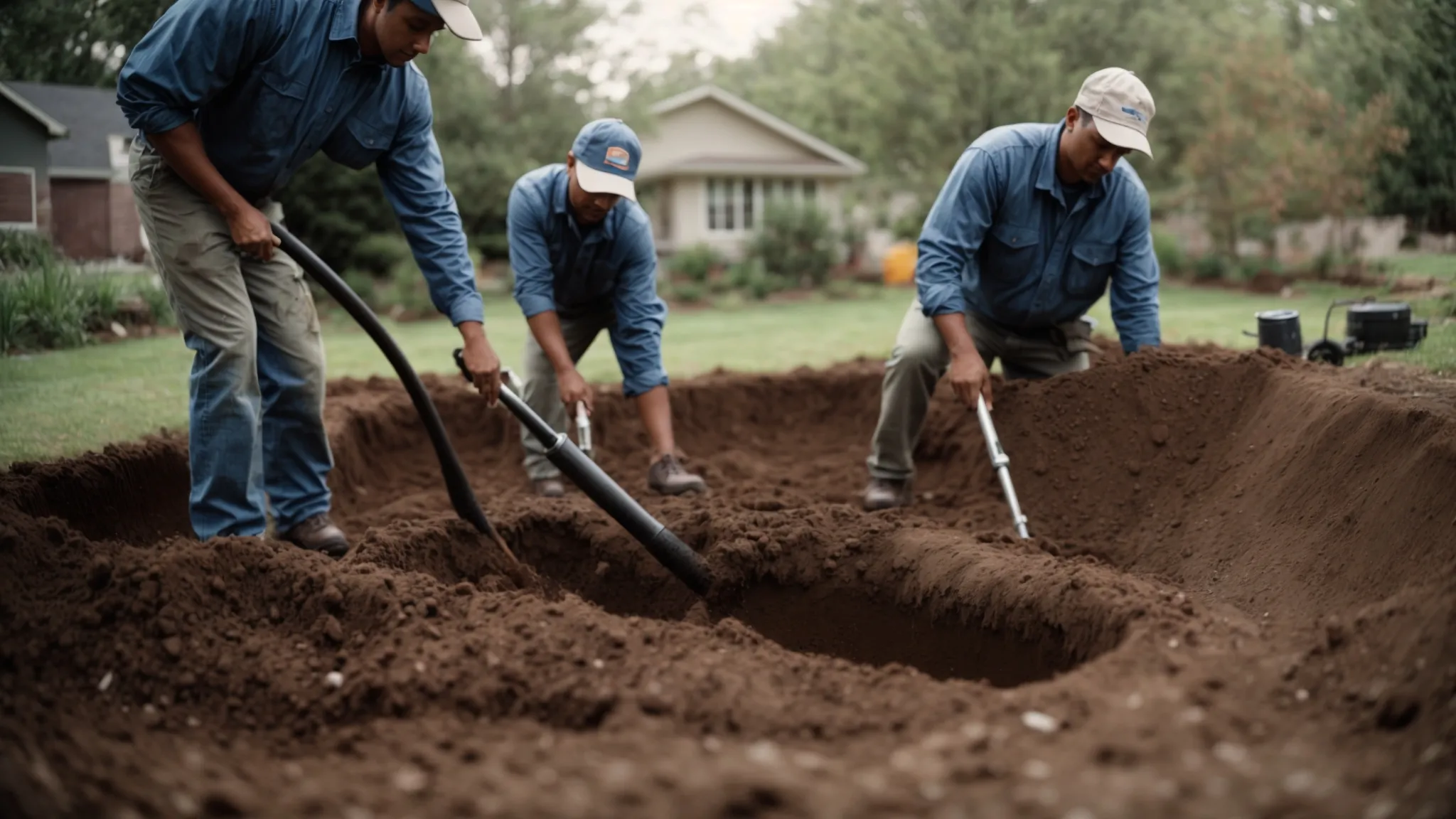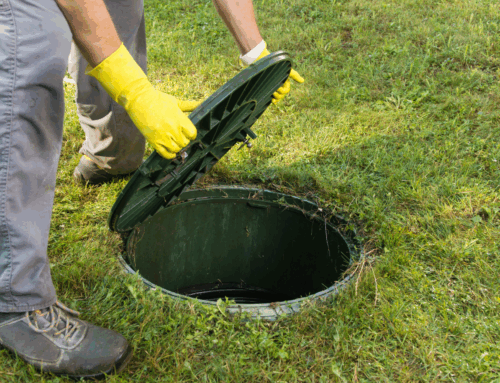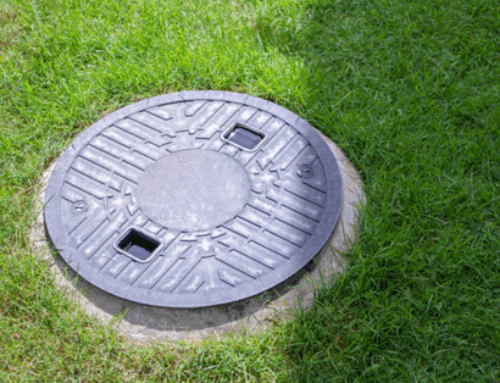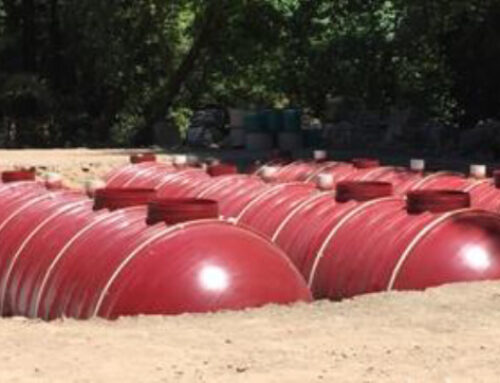The Importance of Your Septic System Drainfield Leach Field Repairs: What You Need to Know
The Importance of Your Septic System Drainfield Leach Field Repair: What You Need to Know–Septic system drainfield leach field repair is a topic that many homeowners face with trepidation, yet understanding essential maintenance techniques can prevent costly damage and ensure a healthy, functioning system.
Frequent inspection and pumping are cornerstone practices that ward off the alarms of septic backup, while efficient water use and proper waste disposal protect the intricate balance of your septic ecosystem. Your lawn’s health, the longevity of your septic system, and, importantly, local water tables rely on your vigilance in upkeeping the drain field.
Envisage a future where emergency calls to septic service providers are a rare disturbance, not a frequent annoyance. Keep reading to learn how an eye toward water conservation and wise waste management can avert the headaches of drain field repair.
Septic System Drainfield Leach Field Repair: Inspect and Pump Frequently
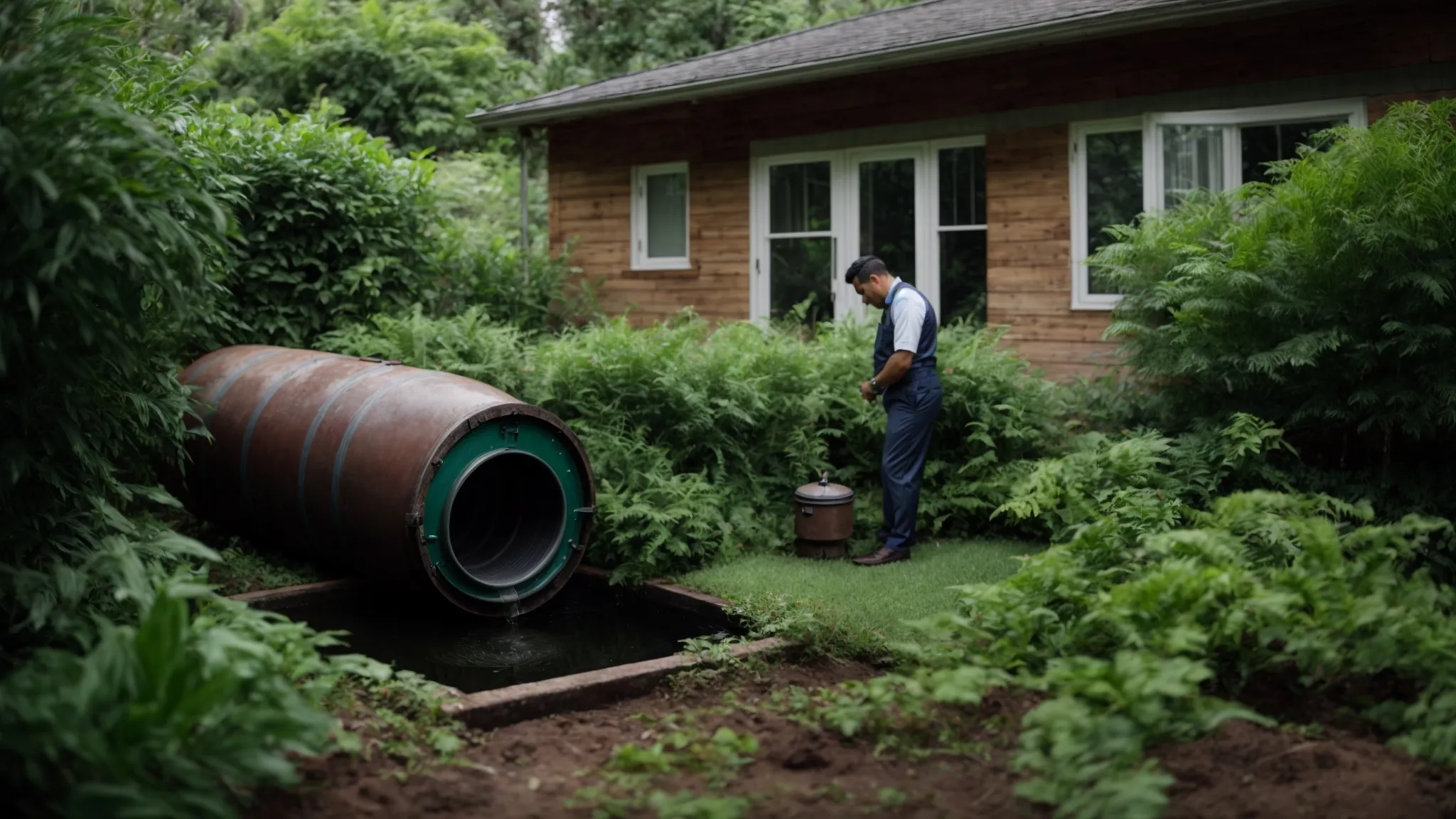
The integrity and functionality of a septic system are essential to maintaining a sanitary environment and preventing the unsavory aftermath of system failure. Vigilant homeowners stay ahead of potential issues by recognizing the early indicators of drainfield malfunction, such as standing water or unexplained odors, which often point to compromised efficiency. For those facing such troubles, exploring options for septic system drainfield leach field repair can be a crucial step toward resolution.
Regular assessments by qualified professionals not only identify current problems but also mitigate future complications through scheduled pump-outs. Moreover, it’s not a one-size-fits-all timetable for these cleanings; adjustments must be considered in relation to the household’s specific water usage patterns. For those looking into more nuanced solutions that cater to different sizes and types of usage, understanding the options available for wastewater treatment can be crucial.
Exploring a comprehensive guide or case study on the matter could provide valuable insights. Castello Di Amaroso is an example of effective wastewater management for specific use cases. These proactive steps ensure the longevity of the septic system and safeguard the health of the property’s residents and surrounding ecosystems.
Identifying Early Signs of Drainfield Failure
Discerning the early signs of drainfield failure is a critical aspect of maintaining a functional septic system. Telltale indications such as lush vegetation over the drainfield area, or the appearance of wet spots where the underground pipes lay, suggest an effluent overflow that requires attention. For more on maintaining healthy drainfields, consider exploring detailed insights and solutions for septic system drainfield leach field repair.
Furthermore, homeowners should remain vigilant for the presence of foul odors near the leach field, a clear sign that soil is failing to properly filter sewage. Should these symptoms be observed, immediate consultation with a septic system professional, perhaps an engineer from BioMicrobics, is imperative to prevent system deterioration and ensure public health safety.
Scheduling Professional Inspections and Pump-Outs
Entrusting the regular inspection and maintenance of one’s septic system to reputable professionals is a critical step in preserving its efficiency. A septic service should schedule regular checks to diagnose potential problems, spacing appointments accordingly based on the demands placed on the system by household occupancy and water usage habits. For more information on maintaining your system’s efficiency, consider exploring options with a wastewater treatment system company.
Professionals, like those trained by BioMicrobics, are well-versed in assessing the intricacies of septic systems and can provide tailored advice on the optimal frequency of pump-outs to prevent drainfield distress. These scheduled cleanings are pivotal in averting the perils of overflow, safeguarding against the costly necessity of drainfield repair or replacement.
Adjusting Pump-Out Frequency Based on Usage
The pump-out frequency of a septic system has a direct correlation with household habits and the volume of wastewater generated. Adjustments are paramount when there is a shift in occupancy or changes in the quantity of water processed, ensuring the system remains within its operational capacity and avoiding undue strain on the drainfield.
Seasonal factors and the presence of high-water-use appliances also dictate the scheduling of septic tank pump-outs. Maintaining an adaptive approach to these variables can extend the life of the drain, preserve soil efficiency, and prevent overloading, which could otherwise lead to premature system failure.
The journey to a healthy septic system doesn’t end with routine checks and cleanings. Embracing water efficiency is the next critical step in safeguarding your home’s wastewater sanctum.
Use Water Efficiently

The efficient utilization of water within a household plays a pivotal role in maintaining the optimal function of a septic system’s drainfield, thus avoiding the need for extensive repairs. To address this, homeowners can take decisive measures to minimize the stress placed on their septic systems.
The installation of high-efficiency fixtures significantly diminishes the water load, reducing the risk of overburdening the delicate balance necessary for effective sewage treatment. Additionally, staggering water usage throughout the day can prevent the sudden influx that often leads to system overloading. Careful management of household water flow not only protects the integrity of the drainfield but also aligns with ecological responsibility by conserving a precious resource.
Installing High-Efficiency Fixtures to Reduce Water Load
Transitioning to high-efficiency fixtures is a constructive step toward reducing the water load on a septic system’s drain field. By installing low-flow toilets, showerheads, and faucet aerators, households minimize the volume of wastewater that requires processing and, consequently, diminish the risk to the septic system’s integrity. For more detailed approaches on maintaining the system’s integrity, consider exploring more about septic system drainfield leach field repair.
Adopting these water-smart fixtures not only contributes to the health of a septic system but also propels a dwelling towards more sustainable water practices. As these efficient appliances require less water to operate, they are instrumental in averting the overtaxing of the drain field and promoting the seamless function of the entire onsite sewage facility.
Staggering Water Usage to Avoid Overloading the System
Mindful coordination of daily water activities can significantly mitigate the risk of overloading a septic system’s capacity. By spacing out the use of water-intensive appliances such as washing machines, dishwashers, and showers, homeowners can maintain a steady and manageable flow into the septic tank, allowing the system adequate time to treat and transfer effluent to the drain field without reaching a saturation point.
Strategic scheduling of household water consumption is vital, especially during peak times or events where the usage is substantially increased. This careful orchestration ensures that the drain field is not subjected to the excessive volume of liquids that can precipitate flooding, a common precursor to the need for drain field repair or enhanced measures such as septic system drainfield leach field repair.
Managing Household Water Flow to Protect the Drainfield
Conscious management of water resources within a home significantly relieves the burden on a septic system’s drainfield. Encouraging practices like fixing leaks promptly, turning off taps when not in use, and only running dishwashers or washing machines with full loads can reduce the flow of water into the septic system, thus maintaining its efficacy.
These simple yet impactful actions can significantly extend the lifespan and functionality of a septic drainfield:
Homeowners must also be mindful of the substances that enter their septic systems, as certain chemicals can disrupt the delicate balance necessary for proper sewage breakdown and absorption. Avoiding the disposal of hazardous materials down the drain plays a crucial role in protecting the drainfield from contaminants that can impede soil percolation.
Maximizing water efficiency paves the way for robust septic system health. Now, let’s shift our focus toward the critical importance of waste disposal’s role in safeguarding our environment.
Properly Dispose of Waste
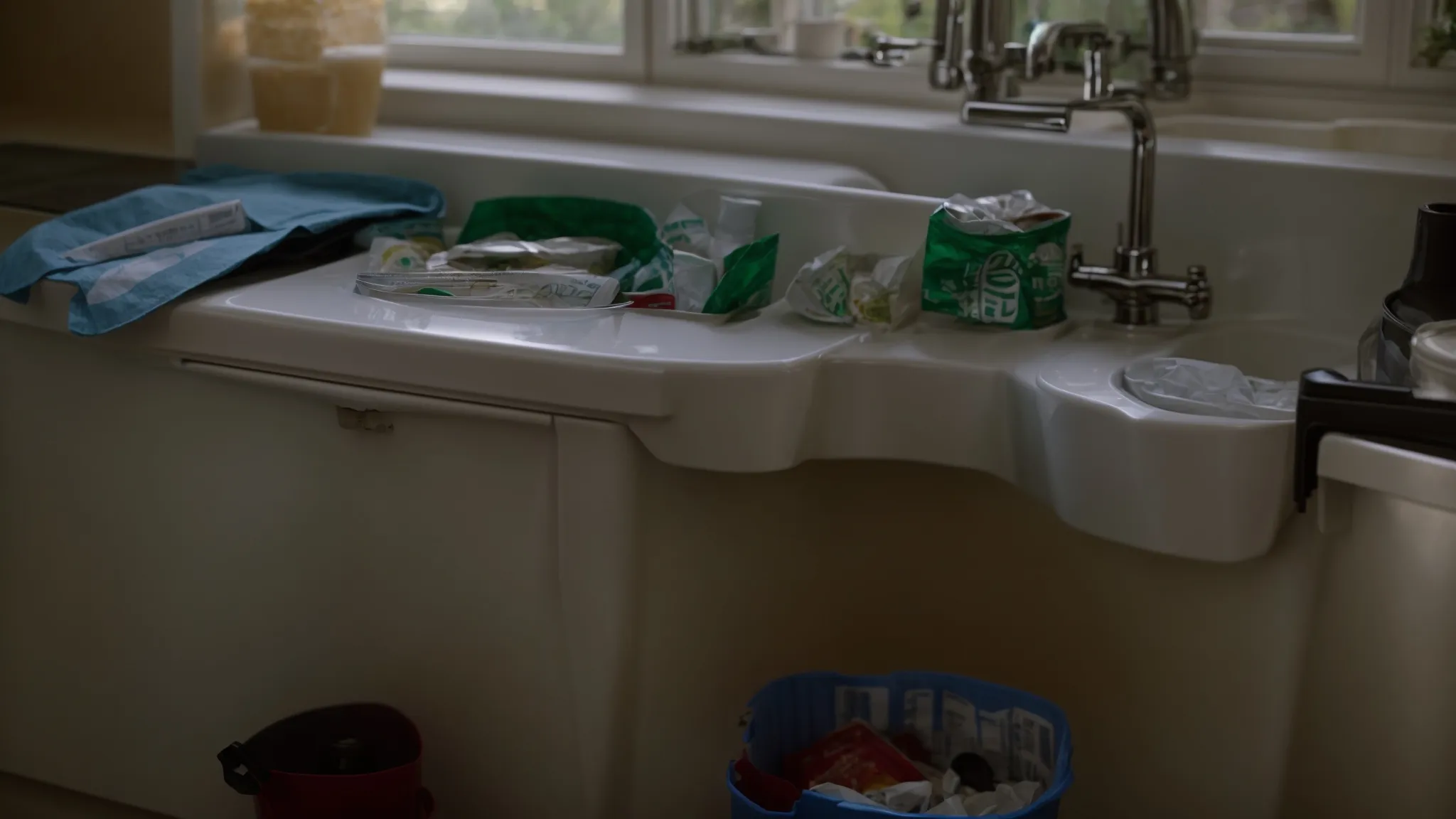
Integral to the well-being of any septic system—and, by extension, the health of the drainfield—is the meticulous management of waste disposal. A discerning approach to what makes its way down the household drains can drastically reduce the need for drainfield repair.
This includes being keenly aware of items that should never be flushed, as they can overwhelm or damage the delicate ecosystem of a septic system. Equally important is the selection of cleaning agents; certain products boast a composition that is safe for septic systems and won’t disrupt the bacterial balance critical for sewage treatment.
Adequate waste disposal practices extend beyond mere awareness, as they are fundamental in preventing obstructions that could lead to blockages and costly system repairs. Through the adoption of these sound strategies, homeowners can sustain the longevity of their drainfields, circumvent the stress of potential failures, and ensure the continuity of efficient wastewater treatment within their onsite sewage facilities.
What Not to Flush Down to Maintain Drainfield Health
To preserve the health of a septic drainfield, vigilance against unsuitable materials entering the system is paramount. Substances such as feminine hygiene products, paper towels, and certain types of wipes, even those branded as ‘flushable’, can create clogs and overburden the drainfield, inhibiting the soil’s natural filtration process.
Comprehensive education on the impacts of waste disposal in household drains keeps a septic system functional. Chemicals like petroleum products, paint, and excessive amounts of cooking oil or grease should never be flushed as they can severely disrupt the microbiological ecosystem essential for treating wastewater and preventing system failure.
Safe Cleaning Products That Won’t Harm Your Septic System
Choosing septic-safe cleaning products is a critical consideration for homeowners seeking to sustain the intricate microbial balance necessary for optimal sewage treatment within their septic systems. These specially formulated products lack the harsh chemicals that can devastate the bacteria responsible for decomposing waste, therefore maintaining the efficiency and health of the entire sewage disposal process.
The unwavering dedication to using eco-friendly cleaners echoes the position of the United States Environmental Protection Agency on safeguarding onsite wastewater systems against harmful substances. By selecting agents free of aggressive compounds like bleach and ammonia, homeowners play an active role in extending the lifespan of their septic tanks and ensuring the uninterrupted functionality of the drainfield.
Proper Waste Disposal Practices to Prevent Blockages
Maintaining unimpeded flow through a septic system’s drain lines necessitates conscious waste disposal habits that bar certain materials from entering the network. Properly sorting solid waste, such as kitchen scraps and non-biodegradable items, to prevent them from reaching the septic tank, plays a crucial role in staving off blockages that require extensive drainfield repairs.
Indeed, the preservation of a septic drainfield hinges on strict adherence to best waste management practices where even minor modifications, like diverting rainwater runoff away from septic fields and avoiding the use of garbage disposal units to limit solid waste, can significantly reduce the incidence of clogs and the associated leach field distress.
Ensuring the safe disposal of household waste is a victory in nurturing your septic system. Now, let’s focus on preserving the unsung hero beneath your yard: the vital drainfield.
Maintain Your Drainfield

A meticulously maintained drainfield is a linchpin in the smooth operation of a septic system, ensuring effective sewage treatment and environmental protection. Homeowners can avert the need for costly interventions by implementing regular maintenance practices focused on keeping the drainfield clear of roots and other obstructions.
Thoughtful landscaping not only improves the aesthetic appeal of the property but can also significantly bolster drainfield function when planned with system health in mind. It is equally critical to monitor and maintain the drainfield cover, which includes the appropriate soil and vegetation overlay essential for the percolation and filtration processes fundamental to any well-functioning onsite sewage facility. Collectively, these practices promote a robust system able to handle the demands of wastewater management.
Regular Clearing of Roots and Obstructions
Ensuring the unimpeded function of a septic system requires diligent monitoring for invasive root systems, which can encroach upon drain fields and cause significant damage. Roots from nearby trees and shrubs seek out the moisture and nutrients surrounding the drainage pipes, potentially breaching and obstructing the system’s flow. For more detailed strategies on dealing with this issue, consider exploring services dedicated to septic system drainfield leach field repair.
Regular maintenance and preemptive actions serve as a bulwark against such disruptions, with professional septic services employing measures like root cutting and the installation of barriers. These strategic steps not only prolong the lifespan of a septic system drainfield but ultimately contribute to the resilience and efficacy of the entire onsite sewage facility.
Landscape Tips to Enhance Drainfield Performance
A well-planned landscape design considers the specifics of a property’s drainfield to optimize its performance and longevity. Selecting shallow-rooted, native grasses and wildflowers like Schizachyrium scoparium or Gaillardia can reinforce soil structure without infiltrating and damaging the septic system.
To maintain optimal drainfield health, it’s advisable to keep heavy equipment and vehicles at bay, as their weight can compact the soil and disrupt the necessary oxygen flow that aids in the efficient treatment of wastewater.
Employing these landscaping strategies forms an integral part of drainfield maintenance, contributing to the septic system’s efficacy and protecting against the necessity for repair or reconstruction.
Monitoring and Maintaining Proper Drainfield Cover
Proactive oversight of the drainfield surface is instrumental to the health of a septic system. Homeowners are urged to maintain an appropriate layer of soil and vegetative cover over their drainfield to support the natural percolation and filtration processes necessary for treating effluent and avoiding liquid saturation.
Continuous monitoring helps in the early detection of irregular conditions such as settling or erosion, which might expose the system components or disrupt efficiency. Timely remediation, including the application of topsoil or repair of the vegetative layer, can prevent costly damage and ensure optimal drainfield functionality.
Maintaining your drain field is just the beginning. Now, imagine the added peace of mind and efficiency that comes with installing a second drain field.
Add a Second Drain Field
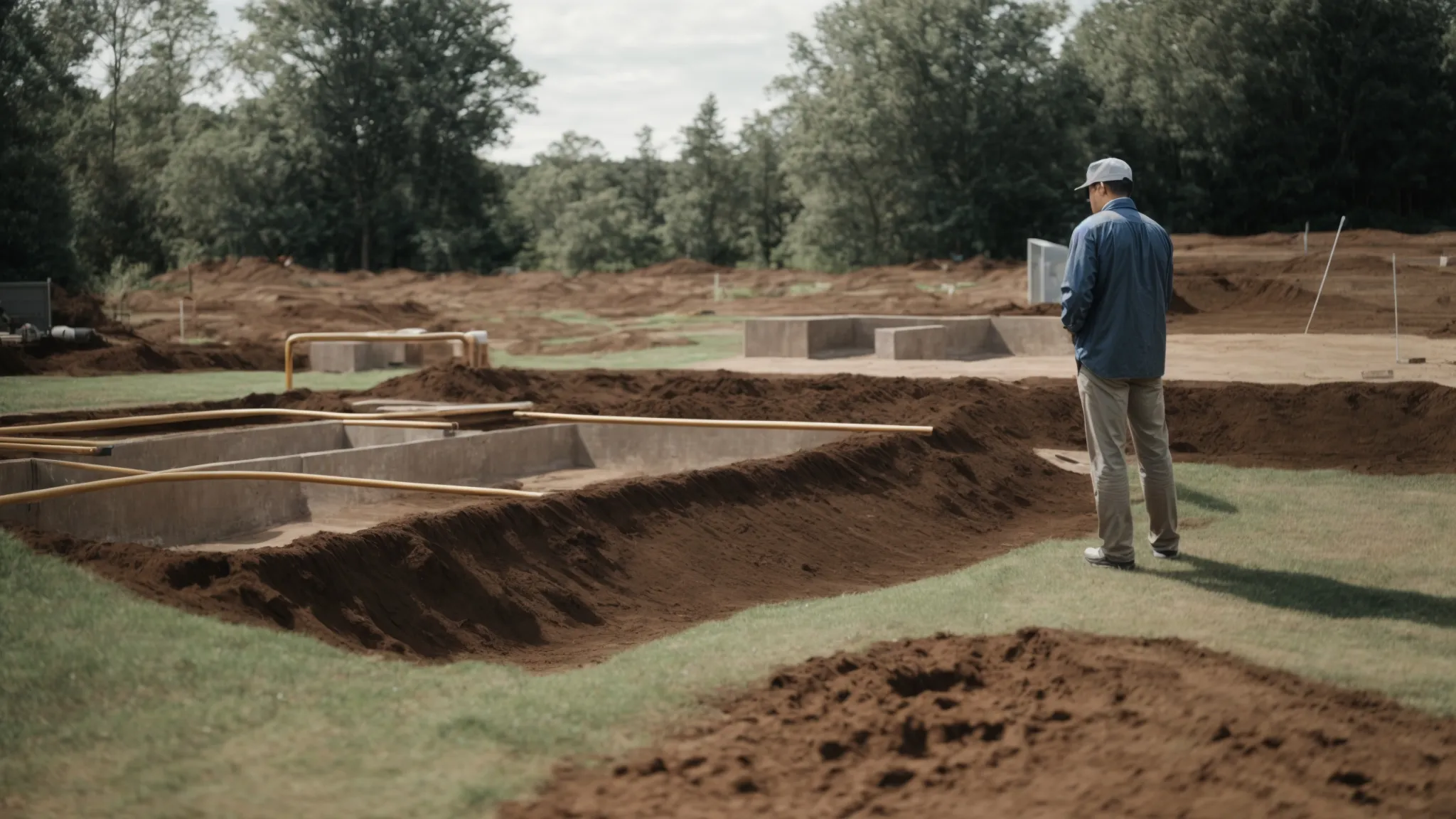
In the realm of septic system upkeep, the addition of a secondary drainfield emerges as a visionary strategy, particularly when the primary system can no longer sustain the burgeoning demands of household wastewater or when it is recuperating from maintenance work. Homeowners stand to gain immensely by considering a secondary drainfield, ensuring their septic system remains operational without interruption.
Addressing when and why to expand into a supplementary drainfield is pivotal, delineating the circumstances that warrant such an expansion. Navigating the steps for integrating an additional drainfield demands methodical planning and execution, leaning on the expertise of seasoned professionals to seamlessly incorporate it within the existing septic framework.
Moreover, the long-term benefits of having a backup drainfield crystallize in the consistently high performance of a septic system, significantly diminishing the likelihood of emergency repairs and enhancing property value – a forward-thinking approach to residential wastewater management.
When and Why to Consider a Secondary Drainfield
The consideration for installing a secondary drainfield oftentimes arises when the existing septic system begins to show signs of strain or reduced efficiency. Over time, the cumulative effects of continuous use can lead to a drainfield that no longer effectively processes septic effluent, warranting the need for an alternative solution to preserve the system’s function and homeowner’s peace of interlude with their waste management practices.
A secondary drainfield also serves as a proactive measure against future system distress. It acts as a rotational system, allowing one field to rest while the other is in use, thereby enhancing the overall longevity and performance of the septic system. Significant lifestyle changes, such as a growing family or the addition of water-intensive appliances, could necessitate this addition to accommodate increased wastewater flows.
Steps for Integrating an Additional Drainfield
Integrating an additional drainfield into an existing septic system commences with a comprehensive evaluation by a qualified professional to determine the best location, considering factors such as soil type, percolation rates, and environmental regulations. This essential assessment ensures the secondary drainfield aligns with the necessary requirements for proper wastewater treatment and is positioned to effectively support the first, avoiding interference with underground utilities or root systems.
Following a thorough site analysis, the actual construction of the secondary septic drain field involves meticulous excavation and installation of new piping and drainage layers. Professional engineers from entities like BioMicrobics oversee the careful connection to the existing system, ensuring the integrity and efficiency of the new addition while adhering to strict standards set by the United States Environmental Protection Agency for wastewater treatment systems.
Long-Term Benefits of Having a Backup Drainfield
The strategic installation of a backup drainfield offers a crucial safeguard for homeowners, providing an alternative route for wastewater during periods of high usage or when the primary system is undergoing maintenance. This auxiliary field ensures uninterrupted service, preventing the inconvenience and health risks associated with septic system downtime.
In addition to operational continuity, a secondary drainfield can significantly extend the overall lifespan of a septic system. By allowing alternating periods of rest, the soil’s natural filtration ability is preserved, enhancing the longevity of the system and reducing the likelihood of emergency interventions due to system overload.
Transitioning from septic solutions to aquatic maintenance, it’s essential to consider the broader waterscape of your property. Now, let’s switch focus to preserving the integrity of your drain field by properly diverting water from your pool or hot tub.
Drain Your Pool or Hot Tub Away From Drain Field

Properly managing the drainage of pools and hot tubs is vital in the maintenance of a septic system’s drainfield. Chlorine, a common chemical used to disinfect pool water, can wreak havoc on the delicate microbial ecosystem that breaks down waste within the septic system.
Similarly, the sheer volume of water from draining these amenities can overwhelm the drainfield, leading to saturation and potential system failure. For more details on addressing this issue, consider exploring options for septic system drainfield leach field repair.
As homeowners consider the implications of these actions, it’s imperative to employ safe drainage practices that avert the contamination and inundation of the septic field. septic system drainfield repair. Exploring alternatives that ensure water diversion steers clear of the septic system is crucial in preserving its functionality and preventing the need for leach field repair.
The Effects of Chlorine and Heavy Water on Your System
Introducing chlorine-laden water or heavy volumes from pools and hot tubs to a septic drainfield can cause significant disruptions to the ecosystem that manages waste decomposition. Chlorine, specifically, is a powerful disinfectant that can kill the beneficial bacteria essential for breaking down sewage, while excessive water from hot tubs can lead to saturation of the drainfield, reducing its ability to properly process effluent.
The perils to septic system functionality from improperly discharged pool or hot tub water extend beyond bacterial disruption. The prolonged exposure to chlorine and the ensuing water surge can compact the drainfield soil, restricting necessary airflow and compromising the soil’s natural filtration ability, leading to potential drainfield failure:
These adverse effects underscore the critical need for alternative water drainage solutions that safeguard the delicate balance within a functioning septic system. Employing best practices for diverting pool and hot tub water will protect the septic environment, ensuring the continual efficiency and longevity of the drainfield.
Safe Drainage Practices to Protect Septic Functionality
To maintain septic system functionality after draining pools or hot tubs, it is critical to channel water away from the drainfield. This practice protects the system by preventing the over-saturation of the soil, which can lead to system inefficiency and the need for drain field maintenance or repair.
Establishing designated zones for safely releasing non-chlorinated water aligns with ecological best practices, thus excluding any negative impact on the septic system’s microbes. By implementing such measures, homeowners ensure the stability and longevity of their septic environment, eschewing the risks associated with contaminated runoff.
Alternatives for Water Diversion That Won’t Harm Your System
In the pursuit of ensuring the integrity of a septic system’s functionality, identifying methods of water diversion that do not compromise the system’s efficacy is indispensable. Homeowners may consider installing a dry well or a French drain as an appropriate alternative for rerouting water from pools and hot tubs, thus circumventing potential damage to the septic drain field.
Further protecting the septic system, the integration of rain gardens can serve as a sustainable solution to manage water flow. Such alternations absorb and filter excess water using plant life, creating a natural barrier that prevents the oversaturation of the drain field.
Frequently Asked Questions
How often should septic systems be inspected and pumped?
Septic systems are an integral part of rural and suburban homes that are not connected to municipal sewage lines, and proper maintenance is the key to their longevity. The frequency with which a septic system should be inspected and pumped hinges on several factors, including the size of the tank, the number of residents in the household, and the aggregate volume of wastewater generated.
As a rule of thumb, the United States Environmental Protection Agency recommends that septic systems be inspected at least every three years by a qualified professional and the tank pumped as recommended by the inspector, usually every three to five years. These inspections are pivotal, as they may reveal problems such as leaks, blockages in the inlet and outlet pipes or issues in the drain field that require prompt attention.
Amidst the busy whirl of daily life, homeowners might overlook the subtle signs of a septic system in need of professional maintenance. Without timely inspections and pumping, solids can accumulate in the tank and flow into the drain field, potentially leading to a clogged drain field and water pollution. Experts such as those at BioMicrobics underscore that regular septic tank maintenance not only prevents costly repairs, such as drain field repair, but is also a matter of public health, ensuring the efficient and safe processing of household waste.
Factors like the use of a garbage disposal unit, or the presence of high water use appliances like a washing machine, can increase the frequency with which inspections should occur. Systems with mechanical components, pumps, or electrical float switches require more frequent inspections, typically once a year. Keeping a detailed record of inspections, pump-outs, and any maintenance activities assists both homeowners and service professionals in managing the system’s upkeep effectively.
What are the best practices for water conservation with septic systems?
Proper water conservation within a household not only facilitates sustainable living but also extends the lifespan and efficiency of septic systems. Managing the amount of water that flows into a septic system is pivotal, as excess water can flood the drain field, leading to costly repairs or replacements. Companies like BioMicrobics offer innovative technologies that enhance sewage treatment and water conservation in residential and commercial septic systems.
Key practices include spreading out water usage throughout the week to avoid overburdening the system on any given day. Installing water-saving devices such as low-flow toilets and showerheads dramatically reduces the volume of water entering the tank. Furthermore, repairing leaks promptly and conscientiously using appliances, like selecting proper load sizes on washing machines, can mitigate the risk of overwhelming the septic tank and drain field.
When considering the comprehensive functionality of a septic system, routine maintenance plays a non-negotiable role in preventing water pollution and ensuring the efficacious management of wastewater. Regular inspections, performed by a professional, safeguard against unexpected system failures that could lead to groundwater contamination. Homeowners should be aware of the location of their septic tank and drain field, ensuring that activities such as gardening or landscaping do not inadvertently damage the underground system.
The practice of diverting other sources of water, like roof drains or surface runoff, away from the drain field helps in maintaining the necessary soil absorption area. Encouraging the growth of grass or small plants over the drain field can aid in evaporation and nutrient uptake, which in turn supports the treatment process by removing water and potential pollutants. With such practices, the effectiveness of a septic system in managing wastewater can be dramatically improved, contributing to the overall health of the envirnoment and promoting sustainable water usage.
What materials should never be flushed into a septic system?
Flushing the wrong materials down into a septic system can be a recipe for disaster, a reality to which many septic tank owners can attest. Unfortunately, common items regarded as flushable often wreak havoc on these delicate systems. Non-biodegradable products will not break down within the septic tank, thereby causing a build-up that can obstruct the flow of waste.
Among the notorious culprits are feminine hygiene products, wipes (even those labeled “flushable”), cotton swabs, and dental floss. These items can create blockages in the septic drain field, leading to costly repairs and unpleasant septic backups. Moreover, substances like cigarette butts and plastic wrappers should never find their way into the septic tank, for they contribute to the accumulation of solids that can choke the system.
Furthermore, various household chemicals and other substances pose serious threats to the ecosystem within a septic tank. Harsh cleaners, including bleach and drain openers, kill the beneficial bacteria that are essential for breaking down organic waste. Medications, especially antibiotics, should also be kept well away from septic systems, as they can exterminate the microbial life that is the linchpin of the sewage treatment process.
Substances like paint, oil, gasoline, and solvents can not only destroy the biological equilibrium but also contaminate groundwater. Disposal of cooking fats, oils, and greases in a septic system must be avoided; these substances solidify and may cause blockages in the pipes leading to the drain field. Wise management of what goes into a septic system safeguards its functionality and prolongs its operational lifespan, hence the importance of strict adherence to best practices for disposal.
How can I maintain the health of my drainfield?
Maintaining the health of a drainfield, an essential component of any septic system, is pivotal for ensuring effective sewage treatment and the longevity of the system itself. The drainfield, also recognized as a leach field or septic drain field, operates ingenously by allowing the liquid effluent from the septic tank to percolate into the underground soil, where treatment continues through microbial activity and filtration. To foster a functional drainfield, avoidance of excessive water usage is critical as it prevents the flood and overload of the system.
Households can achieve this by installing fixtures that conserve water and by spreading out the usage of water-intensive appliances, like washing machines and dishwashers. Regular inspection and pumping of the septic tank, tailored to the tank’s volume and the number of occupants in the home, can thwart the septic system from becoming overwhelmed with solid waste, which may otherwise clog the drain lines leading to the field.
In tandem with these measures, homeowners should be mindful of what goes down their drains, as foreign substances can detrimentally affect the delicate microbial balance within the system. Substances such as household chemicals, excessive grease, oil, and non-biodegradable items pose significant risks—these should not find their way into any septic system.
Additionally, thoughtful landscaping is vital. For instance, planting deep-rooting trees and shrubs at a safe distance helps to ensure that roots do not invade and damage the pipes or the soil’s absorptive capacity. On that note, facilitating proper surface drainage is essential; directing runoff from roofs and paved areas away from the drainfield can prevent saturation.
Meanwhile, companies like BioMicrobics provide advanced solutions for decentralized wastewater management that can enhance the resilience and performance of septic systems, including those with compromised drain fields. With a robust maintenance routine and a judicious use of household products, the health of one’s drainfield can be preserved, making for a happier home and a greener environment.
Should pools and hot tubs be drained away from the drainfield?
Maintaining the proper functionality of a septic system’s drainfield is critical for the health and sanitation of any household. When it comes to the issue of draining pools and hot tubs, it is advisable to avoid discharging large volumes of water directly onto the drainfield area. The sudden influx of water can saturate the soil, inhibiting its ability to absorb and filter effluent from the septic tank effectively.
This saturation may lead to a reduction in the drainfield’s capacity for handling the regular flow from household use, potentially causing backups and malfunctions. Additionally, it can disrupt the delicate balance of microbes in the system—microbes which play a key role in breaking down and treating sewage.
Moreover, the chlorinated water from pools and hot tubs could have detrimental effects on the ecosystem within the drainfield. Chlorine is known to be harmful to the beneficial bacteria that are essential for the breakdown of organic waste within the septic system. Not only does this hamper the treatment process, but it could also lead to further complications, such as the emergence of bio-resistant strains of bacteria.
Companies like BioMicrobics focus on providing solutions that enhance the effectiveness of waste treatment systems by ensuring the balance of microbial activity. It’s important for homeowners to be mindful of any substances entering the septic system—be they from household chemicals, soaps, or even the water used to maintain landscaping. Respecting the ecological balance within the septic system is not just a matter of maintaining function; it’s also about protecting the surrounding environment and groundwater from potential contamination.
Conclusion
Effective drainfield maintenance is pivotal in septic system longevity, necessitating regular inspections, pump-outs, and careful water usage within the household. Adopting proper waste disposal practices, including the use of septic-safe products, secures the balance needed for efficient wastewater treatment.
Strategic landscaping and the implementation of a backup drainfield system can significantly reduce the need for emergency repairs. Ultimately, these proactive strategies maintain system efficiency, environmental health, and can extend the lifespan of both the septic system and its drainfield.

BioMicrobics serves a variety of industries and are known as a residential wastewater treatment system company, and a commercial wastewater treatment system company for multi-family housing, and even small municipal settings.
Our multi-family wastewater treatment system company is a global leader in sophisticated systems. Their creative ideas are made to address the problems of wastewater management in various environments. Our company’s advanced methods guarantee successful and efficient outcomes for everything from high-strength wastewater treatments to septic system drain field leach field repairs.
Our products, such the Aerobic Treatment ATU Unit, are the result of years of experience in actual operations.
Additionally, BioMicrobics offers customized wastewater treatment solutions to niche markets like wineries. Our winery wastewater treatment company‘s dedication to creating robust infrastructures for on-site wastewater treatment is demonstrative of its FITT®-for-purpose philosophy.
This is necessary to keep both communities and the environment healthy. BioMicrobics is well-positioned to bring together international projects and partners to offer a client-focused service thanks to its developing global distributor network.
